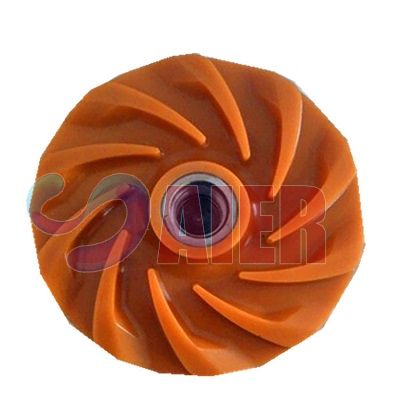Oct . 10, 2025 09:20 Back to list
Submersible Pump Impeller Manufacturer: OEM & Fast Ship?
Inside the world of submersible impellers: what buyers really ask — and what manufacturers actually deliver
If you’ve ever spec’d a sump or slurry pit install, you know the impeller is where performance wins or dies. I’ve toured more pump shops than I can count, and one submersible pump impeller manufacturer that keeps cropping up in field notes is a Chinese outfit producing a polyurethane impeller compatible with Warman slurry pumps. It’s a niche, sure, but stick with me — the details matter.

Product snapshot: Polyurethane impeller (China, Warman-compatible)
The polyurethane impeller is designed for abrasive slurries in mining, sand and aggregate, and industrial wastewater. In practice, PU often runs cooler and shrugs off grit better than cast iron at moderate heads. The trade-off? Upper temperature limits and careful balancing.
| Parameter | Spec (≈ real-world) |
|---|---|
| Material | Cast PU elastomer, abrasion-grade |
| Hardness | Shore A 90 ±3 (ASTM D2240) |
| Abrasion loss | ≈ 70–90 mm³ (DIN 53516; slurry results vary) |
| Temp window | -10 to 80 °C typical; brief peaks ≈ 90 °C |
| Balance grade | ISO 1940-1 G6.3 (G2.5 on request) |
| Nominal speed | Up to ≈ 2200 rpm (check pump curve) |
| Service life | Around 1.2–1.8× vs. metal in fine sand, per customer trials |
How it’s made (brief but practical)
Materials: abrasion-grade PU prepolymer + curative; anti-hydrolysis package for wet service. Methods: CAD vane design, CNC mold, vacuum degassing, precision casting, staged curing, light finish machining, dynamic balancing. Testing: hardness (ASTM D2240), abrasion (DIN 53516 or ASTM G65), tensile/elongation (ASTM D412), dimensional CMM, hydro-run, and balance per ISO 1940-1. I like that they log serials and balance reports — not all shops do.
Where it’s used
- Mining tailings sumps and mill discharge sumps (abrasive, air entrainment)
- Sand and gravel pit dewatering; dredging booster pits
- Industrial wastewater with fines, ceramic slurries, lime handling
Why PU here? Pros and trade-offs
Advantages: abrasion resistance, lower noise, good impact damping, less rotor wear on mating parts. Caveats: watch temperature, chemical compatibility (solvents, oils), and ensure high-grade balancing to keep motor bearings happy. Many customers say the sweet spot is medium head + gritty slurries; I’d agree.
Vendor landscape (quick comparison)
| Vendor | Material options | Lead time | Price index | Certs/QC |
|---|---|---|---|---|
| Aier (China) | PU, Hi-Chrome alt., rubber lining | ≈ 2–4 weeks | $ (cost-effective) | ISO 9001; ISO 1940 balance reports |
| EU Vendor | PU blends, duplex SS | ≈ 4–6 weeks | $$$ | CE materials traceability |
| US Vendor | PU, Hi-Chrome, CD4MCu | ≈ 3–5 weeks | $$ | ISO 9001; PPAP on request |
Customization (where the wins happen)
Options include vane count/profile tweaks, diameter trim, keyway/spline hub specs, G2.5 balancing, and compound tweaks for hot or chemically aggressive sumps. Reverse engineering via 3D scan is common; surprisingly accurate even on worn parts.
Field data and feedback
- Lab data: Shore A 90, tensile ≈ 35 MPa, elongation ≈ 450–550% (ASTM D412); abrasion ≈ 80 mm³.
- Case: Iron-ore tailings sump, 12% solids. PU impeller extended MTBR by ≈ 27% vs. Hi-Chrome; vibration cut by ≈ 18% after G2.5 balance.
- Customer notes: “quieter starts,” “less seal wear,” though a few flagged softening above 85 °C — fair point.
If you’re vetting a submersible pump impeller manufacturer, ask for balance certificates, abrasion test sheets, and a short trial window. Most solid shops won’t flinch.
Compliance and standards
Typical credentials include ISO 9001 QMS, balance to ISO 1940-1, hardness per ASTM D2240, abrasion via ASTM G65/DIN 53516. For critical sites, request material traceability and dimensional CMM reports.
References
- ISO 1940-1: Mechanical vibration — Balance quality requirements for rotors.
- ASTM D2240: Standard Test Method for Rubber Property—Durometer Hardness.
- ASTM G65: Standard Test Method for Measuring Abrasion Using the Dry Sand/Rubber Wheel Apparatus.
- ISO 9001: Quality Management Systems — Requirements.
Note: Specifications are approximate; performance varies with slurry chemistry, solids loading, NPSH, and operating duty.
Looking for a proven submersible pump impeller manufacturer? Shortlist the ones who share raw test data and let you trial under your actual duty — that transparency usually predicts uptime.
-
Reliable FGD Pump Manufacturer China | Durable & Cost-effective Solutions
NewsNov.23,2025
-
Reliable fgd Pump Manufacturer Solutions for Emission Control | Aier Pumps
NewsNov.23,2025
-
Explore Advanced FGD Pump Factory Solutions for Cleaner Power Plants
NewsNov.22,2025
-
Reliable & Efficient FGD Pump Chinese Supplier for Cleaner Energy Solutions
NewsNov.22,2025
-
Reliable China FGD Pump Suppliers for Effective Flue Gas Desulfurization | AiEr Pumps
NewsNov.22,2025
-
China FGD Pump: Durable & Efficient Solutions for Emission Control
NewsNov.21,2025
